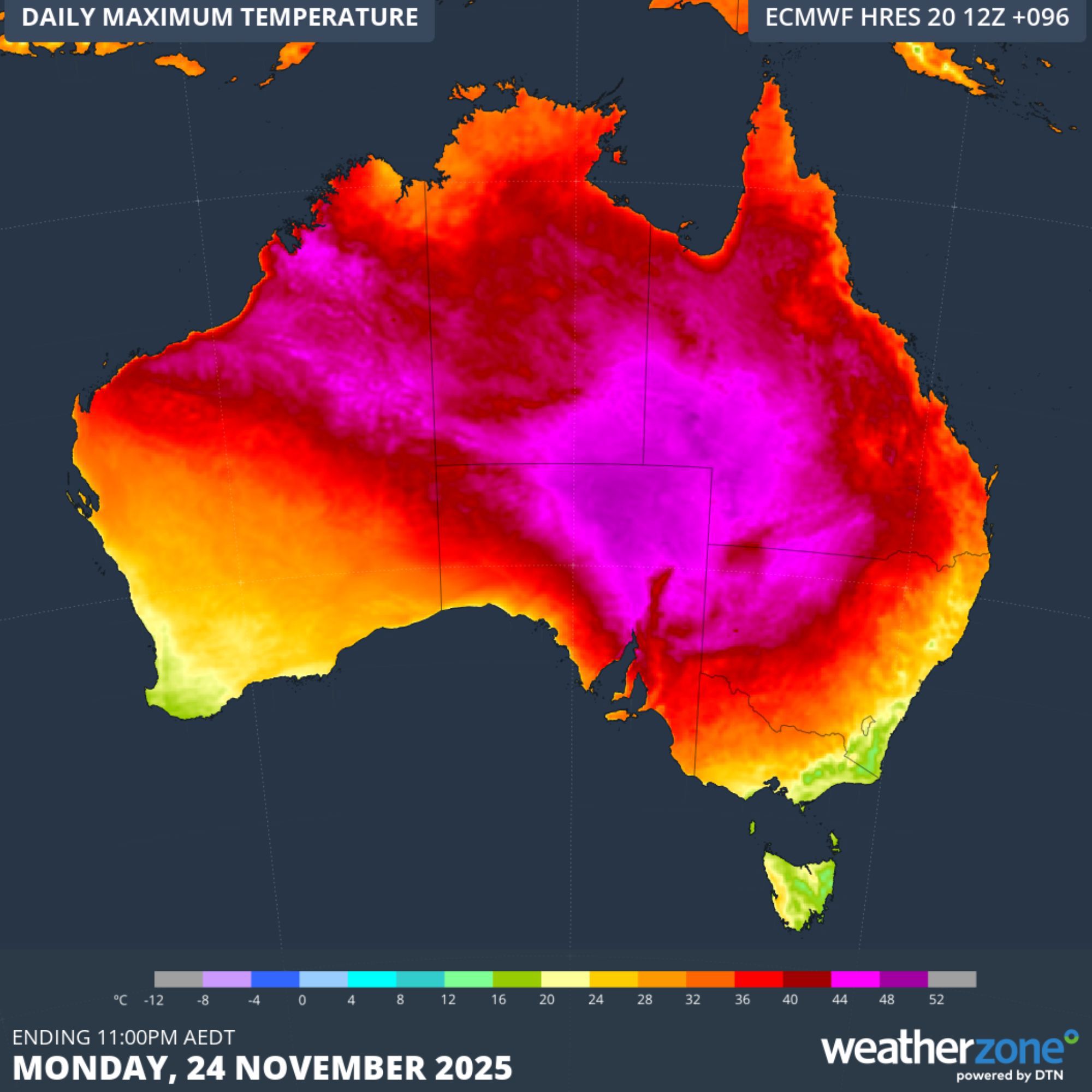
Hot air generated by the fierce giant storm has been propelled south, and multiple states will feel the impact.
While the immediate impact of Tropical Cyclone Fina is over, its impact on weather conditions for southern Australia will be felt this week, forecasters say.
The fierce storm that lashed Darwin over the weekend generated a huge hot air mass, which is gradually moving into the south-east of the country, reports Weatherzone.
Its impact will cause a late spring mini heatwave in multiple states today, with the mercury climbing to a maximum 47 degrees in south-west Queensland and 46 degrees in parts of South Australia.
READ MORE: Cyclone Fina cuts power, fells trees across Northern Territory

Queensland officials have put out an extreme heat warning for the Peninsula, Gulf Country, Northern Goldfields and Upper Flinders, North Tropical Coast and Tablelands, Herbert and Lower Burdekin, Central Coast and Whitsundays and North West districts.
Residents in SA's Eastern Eyre Peninsula, Flinders and Mid North regions are being warned to expect extreme fire danger today.
Warm temperatures will also extend to north-west NSW and parts of the Northern Territory, where maximums in the low forties are forecast.
NSW authorities have issued a severe heatwave warning for the Northern Rivers, Mid North Coast, Northern Tablelands and Upper Western districts lasting until Wednesday.
In the Northern Territory there is a severe heatwave warning today and tomorrow for Barkly, Simpson, Lasseter and Tanami.

The origin of the heat burst is over the Timor Sea, off Darwin, where Fina sucked in huge amounts of heat from the water and propelled it into the upper atmosphere.
By today, this air has reached southern states powered by a high pressure system.
Meteorologists say much of the moisture has been lost, but air will gradually become hotter as it descends to central Australia, a process they call adiabatic warming.
While these conditions are not unusual for late spring, they may nudge seasonal heat records.
 Teen arrested after 17-year-old allegedly stabbed to death near school
Teen arrested after 17-year-old allegedly stabbed to death near school
 Thai woman found alive in coffin after being brought in for cremation
Thai woman found alive in coffin after being brought in for cremation
 Parents of boy killed in jet ski accident say death was preventable
Parents of boy killed in jet ski accident say death was preventable
 Australia made a world-first move. Others are copying
Australia made a world-first move. Others are copying
 'Absolute chaos': Police recount fatal Sea World chopper crash
'Absolute chaos': Police recount fatal Sea World chopper crash
 Apple Watch lost at sea reclaimed after month-long journey
Apple Watch lost at sea reclaimed after month-long journey
 Pauline Hanson wears burqa in Senate chamber in repeat of earlier stunt
Pauline Hanson wears burqa in Senate chamber in repeat of earlier stunt
 Union calls for Melbourne metro opening delay as premier insists it's safe
Union calls for Melbourne metro opening delay as premier insists it's safe
 Reggae giant and The Harder They Come movie star Jimmy Cliff dead at 81
Reggae giant and The Harder They Come movie star Jimmy Cliff dead at 81
 Storms rip off roofs, dump monster hail and leave 100,000 without power
Storms rip off roofs, dump monster hail and leave 100,000 without power
 Bureau of Meteorology asked to explain why new website cost $92 million more than reported
Bureau of Meteorology asked to explain why new website cost $92 million more than reported
 Four charged after $170 million worth of cocaine found floating off WA
Four charged after $170 million worth of cocaine found floating off WA
 Nine out of 10 employers fearing for staff's safety as retail crime rises
Nine out of 10 employers fearing for staff's safety as retail crime rises
 'Human filth': James Packer unleashes on ex-premier
'Human filth': James Packer unleashes on ex-premier
 Regional Queensland among least affordable for renters across country
Regional Queensland among least affordable for renters across country
 Skye Gyngell, the first Australian woman to win Michelin star, dies aged 62
Skye Gyngell, the first Australian woman to win Michelin star, dies aged 62
 Chris is only 17 but he and his schoolmates worry they won't ever afford a house
Chris is only 17 but he and his schoolmates worry they won't ever afford a house
 Doesn't exist': DOGE is done for – eight months early
Doesn't exist': DOGE is done for – eight months early
 UK PM says Andrew should testify in US Epstein probe
UK PM says Andrew should testify in US Epstein probe






